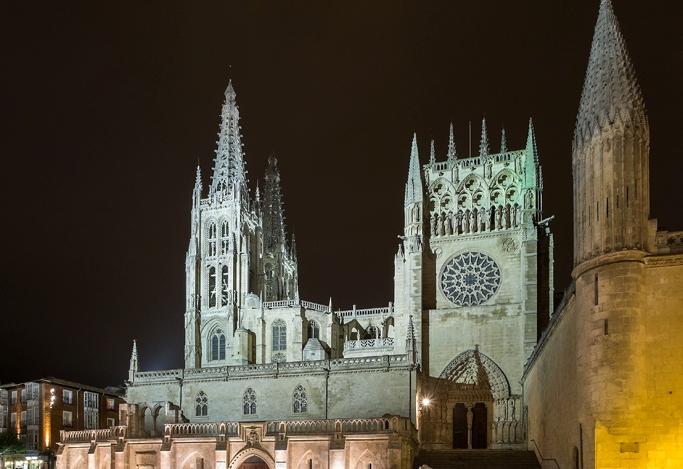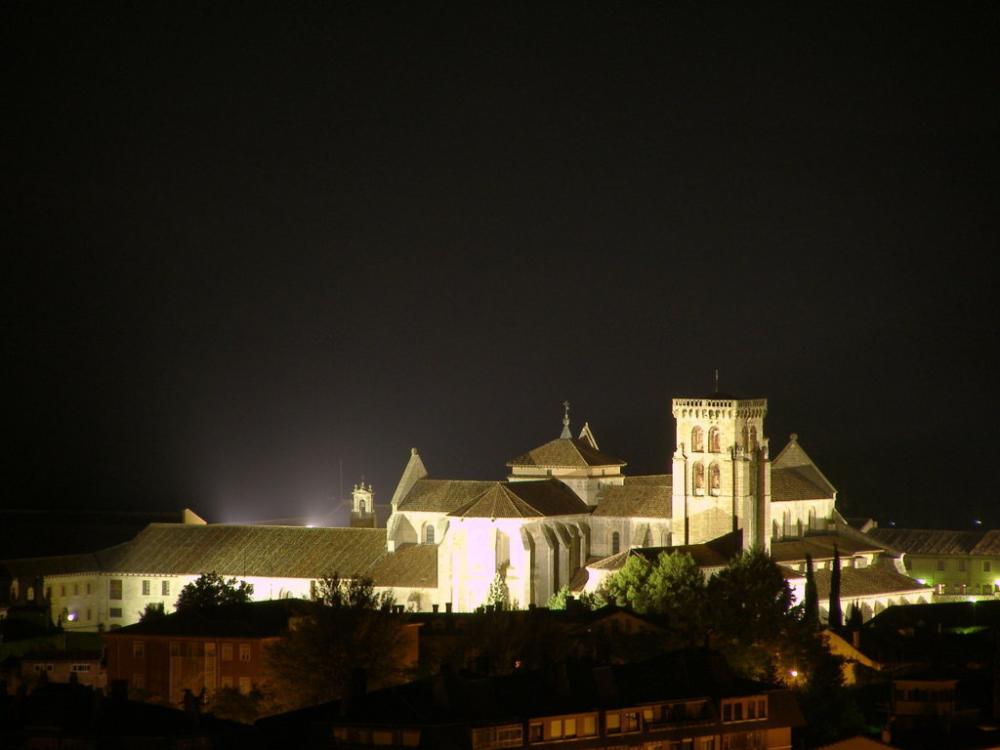1-CATHEDRAL OF BURGOS
This night walk starts at the Cathedral, at the foot of the flagship monument of the city that this walk takes us around. After contemplating the beauty of the first temple of Burgos, with its characteristic sleek spires which are the work of Juan de Colonia, we head for the old Fernán Gonzalez street, home to San Nicolas Church and, a little further on, the Palace of Castilfalé, builttowards the middle of the 16thcentury and home of the Municipal Archive. Later, we head into the maze of the medieval district to see the Church of Santa Águeda, the old Santa Gadea, famous for the oath of El Cid, which cost him his exile from the Kingdom of Castile.
2- ARCHBISHOP PALACE
After leaving behind the Archbishop Palace and the Salesas Church we head to the Monastery of Las Huelgas, with the tower of its church lit up to reveal the location of this old royal place of entertainment which was turned into a royal pantheon in the Middle Ages.. The cloister andPlaza Compás de Adentro take us back in time. Its internal wealth and the Museum of Rich Fabrics make the visit to Las Huelgas a must. The nearby “Parque del Parral” was a property of the crown, that finishes in the Hospital del Rey, currently home of the University of Burgos and the pilgrims care centre, founded by King Alfonso VIII.
3- PASEO DE LA ISLA – PASEO DE LOS CUBOS
Paseo de la Isla, with its illuminated archesleads us though the noble part of the city, full of 19th century buildings, but just before entering the old walled city we can cross the river to admire the facade of the Cardenal López de Mendoza high school, and the church of La Merced, a late Gothic-style temple which is the work of Juan de Colonia. Crossing the Arlanzón river again towards Paseo de los Cubos we will find part of the wall that protected the city back in 13th century; this section contains the entrance to the old Jewish quarter, next to Doña Lambra Tower, where the local synagogue communicated with the city beyond the walls. A little further on is the Francisco Salinas Cultural Centre, set up in the old Municipal Grain Market, in a building that dates back to 1514 and has been used as a wheat silo and prison.
4- SAINT MARTIN’S GATE:
We enter the city once again through one of its main gates, San Martin’s gate, a Mudejar style, horseshoe arched gate, work of Moorish builders from the beginningof the 16th century. The Site of El Cid is also within view, a monument erected in his honour, the monument-mausoleum of the Spanish War of Independence guerrilla fighter Juan Martín “El Empecinado” and Fernán González Gate, erected in honour to the first count of Castile.
5- THE CASTLE
The first slopes of the hills of La Blanca and San Miguel introduce us to the Castle’s beautiful park. In the first we can see the remains of the old fortress, restored and open to tourists. From its battlements and from the castle’s viewing platform, the panoramic views of the city and set of monuments are impressive and it reallyis worth stopping for a moment to take it all in.
The descent back from the viewing platform ends facing the Gothic Church of San Esteban, which hosts the Altarpiece museum. The MudejarGate of San Esteban opens up again in the walls, as does the Gate of San Gil, an old prison of the nobility where the wall reached its maximum height and where the Church of San Gil stands, a 14thcentury Gothic church, with a modest facade and impressive and rich interior.
6- PLAZA ALONSO MARTINEZ – PLAZA DE ESPAÑA- PLAZA SAN JUAN
The expansion of the city can be seen from the building that houses the current Military Museum -the ancient Gate of Margarita del Burgos- and the nearby Plaza de España, from where we have access to the historic buildings of Plaza San Juan, comprising San Lesmes church, rebuilt in the 15th century, with an ogival facade by Simón de Colonia, the Monastery of San Juan, home to the Museo Marceliano Santa María (currently in the process of being restored) and the ancient San Juan Hospital, whose façade is the only part of the building that has been preserved, and has been restored as a Public Library. Just a few steps further we find the Convent of Las Bernardas, from the 16th century, which houses the Municipal Conservatory. Now we go through the Gate of San Juan, the traditional entrance gate to the city of the Jacobean pilgrims, and now we turn left, going through La Puebla street, which leads into Plaza de La Libertad; here we will find Casa del Cordón, a superb palace of the Constables of the Kingdom of Castile, which is attributed to Simón de Colonia, and in which the Franciscan rope of its façade stands out.
7. PLAZA EL CID
The equestrian statue of El Cid marks the entrance to Paseo Espolón, where many majestic Renaissance buildings are located, such as the Palace of the ProvincialCouncil and the Teatro Principal, among others. Parallel to Paseo Espolón, on the other side of the river, Paseo Espoloncillo houses a “Glera”, a place where, according to the poem “Cantar del Mío Cid”,El Cid and his troops rested the night before of leaving the city on their route to exile. The Paseo finishes in front of the gate of Santa María, a triumphal arch honouring the figure of Emperor Charles V, rebuilt over the main access gate to the fortified city during the Middle Age. To the right hand side of the arch we can see Paseo Espolón once again, from where there’s a direct access to the Plaza Mayor and the City Hall building, built above the old gate “of Carretas” at the end of the 18th century in a neoclassical style.
8-OTHER ILLUMINATED BUILDINGS
Slightly further away from the city centre, but also worth visiting in this Route of Light, is the Church of La Real y Antigua de Gamonal, 13th century Gothic, and the Carthusian Monastery of Santa Maria de Miraflores, one of the finest examples of Gothic art from the end of the 15th century. The original building, built in 1401 as a hunting lodge, was donated by Juan II to the Carthusian monks with the aim of turning it into a royal pantheon. After being destroyed due to a fire, Juan de Colonia, with the support of Isabella I of Castile, in 1454, started the work to transform it into a Monastery. This workwas continued later by his son, Simón de Colonia, and in 1499 the Monastery’s church was inaugurated.




